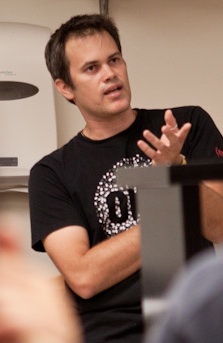Talk of the Arts: A Call to the Raven-like
 Three Opportunities for Vermont Creatives
Three Opportunities for Vermont Creatives
by Lars Hasselblad Torres
Bernd Heinrich, writing in “Mind of the Raven,” draws the reader deeply into the social life of this magnificent bird. The emeritus University of Vermont biology professor paints the picture of the Raven—a shy, alert, keenly sighted and far-ranging creature that is a common feature of the North American landscape.
How like the raven we artists can be – our attentiveness to our surroundings and shared powers of observation, our propensities toward shyness and retreat and, for better or worse, our resistance to the new and the unknown. Our habits, built on practice, run deep – they don’t change as easily as we like to think.
And like the raven, though we’re familiar upon the landscape – our work is in cafes, storefronts, public buildings, the homes of friends and strangers, even reproduced on coffee cups and advertisements – reading about the raven made me realize how little, in fact, we artists are known and counted.
While artistic output is celebrated as essential to “place,” to lending character and improving the “quality of life” in communities throughout Vermont, artists – and the arts institutions created by, fueled, and led by artists – are not yet essential to our economic development strategies.
So closing this gap between awareness and recognition – the difference between being seen and being counted – is core to Vermont’s Office of the Creative Economy.
Here are three ways in which the Office seeks to work across Vermont’s creative economy – which includes the arts and cultural sector – to help ensure that the arts, and we as artists, are seen and counted.
First, we’ve got to keep pushing at the definition of the arts, continue to break down increasingly unrealistic barriers that separate disciplines and forms of expression. This opportunity is at least in part why the Office is eager to partner with diverse groups – from the Vermont Arts Council to Champlain College to the Woodstock Digital Media Festival – to host conversations like “The Art of Video Games” and “The Maker Movement and STEAM in Education.” From a purely economic perspective, there is a tremendous cultural and entrepreneurial value that can be unlocked at the intersection of the arts and technology. So we need to extend networking opportunities, foster opportunities for creative convergence and collaboration in a volatile, dynamic arts marketplace.
Second, we’ve got to expand entrepreneurial thinking and opportunity through arts-based enterprises. Vermont ranks well for its number of artists per capita – we’re about 5th in the nation – and for the startup rate of small businesses that employ tens of thousands of Vermonters. At the latest count, nearly 8,000 of those jobs are in the arts and cultural sector, created by 2,600 arts-related ventures. Total, that’s only about 3 percent of Vermont’s workforce and doesn’t count the independent, self-employed creatives. We’ve got a lot of work to do to develop robust indicators and support mechanisms to finance and grow creative enterprises and cultivate new voices. A key to this is going to be an increase in the amount we’re investing in the arts as a state while experimenting with ways to leverage alternative funding mechanisms like Kickstarter and Launcht.com.
Third, we have got to expand our arts market. In the same way that Vermont’s best products are consumed far beyond our borders (Vermont exports goods valued at $4.1 billion) we need to actively support arts access into new markets if we’re to see our artists survive and thrive in Vermont. This means we’ve got to get better at telling the Vermont story – why these Green Mountains offer such a vibrant creative harbor – not just to ourselves, but regionally, nationally, and internationally. This is going to take some good research, strategy, and collaboration but there has to be a way to take our creative output – from glass blowing to plein air painting, from synthpop to genre films – and translate that into a commercial dividend that is captured in-state and shared by artists.
These three challenges for the creative sector – fostering multidisciplinary collaboration, bringing focus to entrepreneurial support, and building momentum behind arts marketing – are also exciting opportunities for Vermont. Our communities have unique assets, from the historic imprint of our built environment to our legacy of innovation and self-reliance that we can build on. Harnessing these opportunities will not be easy – it will require us to apply raven-like qualities of alertness to opportunity, our vision to seeing new pathways forward, our willingness to roam extended across new disciplines and new markets, our social instincts toward fostering collaboration, and our inventiveness to problem-solving.
Lars Hassleblad Torres serves as the Director of Vermont’s Office of the Creative Economy within the Agency of Commerce. He lives with his family in Cabot, Vermont. An earlier version of this article was presented in opening remarks at the Vermont Arts Council state-wide Arts Summit in October.





















































